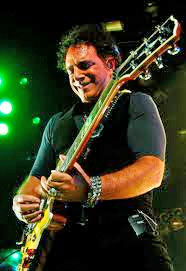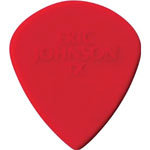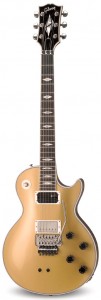Neal Schon on Rigs, Santana, EVH and…Salami
 Neal Schon famously toured with Santana when he (Neal) was 15. He then bolted with a couple of bandmates and co-founded one of the biggest U.S. rock bands, Journey. He has chops and feel, plays great blues and apparently is a cool dude. What’s not to like about this guy?
Neal Schon famously toured with Santana when he (Neal) was 15. He then bolted with a couple of bandmates and co-founded one of the biggest U.S. rock bands, Journey. He has chops and feel, plays great blues and apparently is a cool dude. What’s not to like about this guy?
Here’s more about his experience, gear and techniques.
> On his early start, from a Guitar Player interview: “I was just really focused. I really knew what I wanted to do, and I think that was the main factor in everything falling into place for me. It was a pretty mind-blowing and jaw-dropping experience to be in Santana that young. I mean, what a great band! When I first joined up, I was a fired-up speed-gun blues guitar player who had studied a lot of Beck, Hendrix, Clapton and Page. I also loved Albert King, B.B. King, Albert Collins and Michael Bloomfield, and my goal was to put all those guys together in one style and then speed everything up and make it really accurate. I think I became more tasteful after touring the world with Santana.”
> On EVH, from the same interview:
What was it like having Van Halen open for you in 1978?
It was like getting your ass kicked every night by the best sword-swinging sushi chef in the land. I had seen a lot of guitar players by then, but I’d never seen anything like him. Somebody had given me that first Van Halen album and I remember sitting with my record player and a guitar trying to figure out what he was doing, and for the first time in my life I was stumped. I had no clue until I saw him and realized he had both hands on the fretboard. I’d met Harvey Mandel years earlier, and saw him do that a couple little tapping things, but Ed was taking everything to a much crazier level.
But it wasn’t just the tapping you dug about EVH, right?
It was everything. Ed is one of the greatest rock and roll guitar players of all time, and as far as being an innovator and taking it to the hilt, he’s right up there with Jimi and everyone else. And he didn’t come any better than on that first tour with us when we were touring Infinity – our first record with Steve Perry – and he was touring Van Halen’s debut. They opened every night, and Ed played with extreme fire and loose abandon. Ronnie Montrose was supporting, and he hated being in the middle slot. I would tell him, “Man, I’m glad you have to follow that and not me.” [Laughs.]
> Setup: “I usually use .009-.042 D’Addario strings, because I don’t like my guitar to be too hard to play, and your tone really lies between your guitar, your amp and your fingers, not your string gauge [interesting!]. But I do like the action to be a little more meaty than some players do. I went to one of Joe Satriani’s rehearsals recently. He let me plug in, and honestly, I couldn’t get anything out of his guitar because the action was so low. And when Ed [VH] showed me one of his new guitars, it was too easy to play—he had .009s tuned a half step below standard, and my fingers were just falling off the fretboard.”
> Salami: “Wes Montgomery used to say in interviews that he liked playing after eating a salami sandwich because the grease acted like Finger-Ease, and that that was one way he got such a smooth sound with his thumb and fretting fingers. I swear to God, every time I get a new guitar now, I take the strings off, get some sliced salami, and rub it up and down the fretboard, and let the grease soak in. Then I wipe off the neck and string it up. With new wood, it works really well. You’d be surprised. And sometimes [wipes forehead and then starts playing] I use my own grease. It’s organic!”
> Picking: “You know who I actually pick like? John McLaughlin. The crazy thing is that even though I was a huge Mahavishnu freak back when Journey first started, and still am, I never learned to pick from McLaughlin. But I caught up with him before a show recently in San Francisco, and when he started warming up, I noticed he was slicing the strings sideways with the pick, and that’s exactly what I’ve always done. I’ve never played straight on. On stage, I use Dunlop [483 Classic Celluloid] medium picks. Heavy picks feel kind of stumbly to me. But when I’m warming up, sometimes I use those pointy little Dunlop Eric Johnson [Classic Jazz III] picks. Those are really great to practice with, because they build up your accuracy. When I come back to my normal picks after that, it feels really easy because the other pick is so hard it’s like playing with a piece of bone or something.
Rigs Through the Years
Misc notes trolled up:
‘80s
At some point in the ’80s (Escape and Frontiers era) Neal was using modded Hiwatts, modded at Leo’s Music of Oakland, Calif. Apparently Jeff Watson of Night Ranger and and Paul Dean of Loverboy had similar amps.
The mods apparently were internally bridged channels and possibly more gain.
Do you hear Hiwatt in this clip?
’95 Live Rig
A quote from Neal: “I’ve been using a Roland ME-10 [FX unit] powered by a couple of Marshall heads in stereo into two 4×12 cabinets.”
’08 Live Rig
From the same Nov. ’08 Guitar Player interview:
“My new Marshall JVM heads and Diezel VH4s are almost identical in the way they talk to each other and turn effects loops on and off for different settings. The TC Electronic G-System adds effects and changes everything at once. The Boss GT-6 is mostly for my in-ear monitors mix. The setup runs really smoothly, actually.
“Sure, the cabinet count has grown and grown because there’s only one guitar in the band – and sure, I could play through one Marshall in mono and just crank it on 10. But those five cabinets aren’t really that loud – they can’t be because honestly, my ears are fried and I’m constantly dealing with tinnitus. The extra cabs are really just there to simulate the ambience of a hall or a coliseum. We play a lot of sheds [amphitheaters] where the sound just goes out and doesn’t come back, so I have some cabinets set wet with effects so my area of the stage sounds like I’m playing indoors.
Gear notes from the article:
> When Schon’s tech, Adam Day, is asked if he can think of a more complex stage rig, he can only cite the Edge’s famously elaborate U2 setup. Schon’s backline setup starts with a Lectrosonics wireless. From the receiver back in his amp racks, Schon’s signal passes through 45-foot Mogami cables to and from his pedalboard, which includes a Dunlop Buddy Guy Wah, a Boss compressor pedal used mostly for Strat solos, and Xotic AC- and RC-Booster pedals. (“Lectrosonics systems tend to run a little bright, so the extra capacitance created by all that long cable actually serves to balance out the sound a bit.â€) A TC Electronic G-System controller at Schon’s feet handles all MIDI-implemented effects and amp channel changes, an expression pedal controls the overall delay level (the delay time seems to work nicely for most songs when set to 600ms), and Schon uses a Gibson Digital Echoplex to create the loops he solos over during instrumental interludes between songs. That’s the simple part.
> Things get more intricate back at the amp racks where Schon’s signal is split five ways [!] courtesy of Framptone Amp Switcher and 3-Banger pedals. One signal feeds a drawer-mounted Boss GT-6 processor that runs through a Demeter tube preamp into a Roland M-120 Line Mixer feeding Schon’s in-ear monitors as well as a Marshall Dual MonoBlock power amplifier driving two 1960B 4×12 cabinets in stereo. Schon’s signal is also split between two Marshall JVM half-stacks with G-System effects in their loops, and two Diezel VH4 heads running in stereo courtesy of an Eventide Eclipse processor in their loops (used primarily to fatten things up occasionally with “a little detuneâ€). Each Diezel drives a separate 4×12. And because one is run flat out to get a full sound, its cabinet is turned backwards and miked up behind the stage, thus keeping Schon’s stage volume down.
> The only truly standard features on a Neal Schon Les Paul are the tuning machines and the Gibson BurstBucker Pro bridge humbucker. The neck heel has been heavily sculpted—almost erased—to grant easy access to the high frets, and the fretboard is angled more parallel with the body than those on standard Les Pauls so that the Floyd bridge sits flush. The neck pickup cavity is occupied by a single-coil-sized DiMarzio Fast Track 2 humbucker and a Fernandes Sustainer Driver. The knobs are widely spaced and have been rewired to include a master volume, a push/pull master tone (the pull position activates a Vari-Tone-type circuit that gives Schon “wah sounds without a wah pedalâ€), and a master Sustainer volume. The mini-toggle switches behind the tailpiece control the Sustainer settings. And if you take an MRI of Schon’s cherry sunburst Paul, you’ll discover it has been chambered for weight reduction.
Neal sure likes amps with a lot of knobs! (Cool seeing him play “Mother, Father, Sister” or whatever the name of that tune is!)
Category: D’Addario, Diezel, Hiwatt, Les Paul, Marshall, Neal Schon/Journey, TC Electronic, Xotic
















Schon's now using Tom Andersons, he's ditched Gibson
He’s also now using the Axe-Fx instead of all those amps and effects.